-
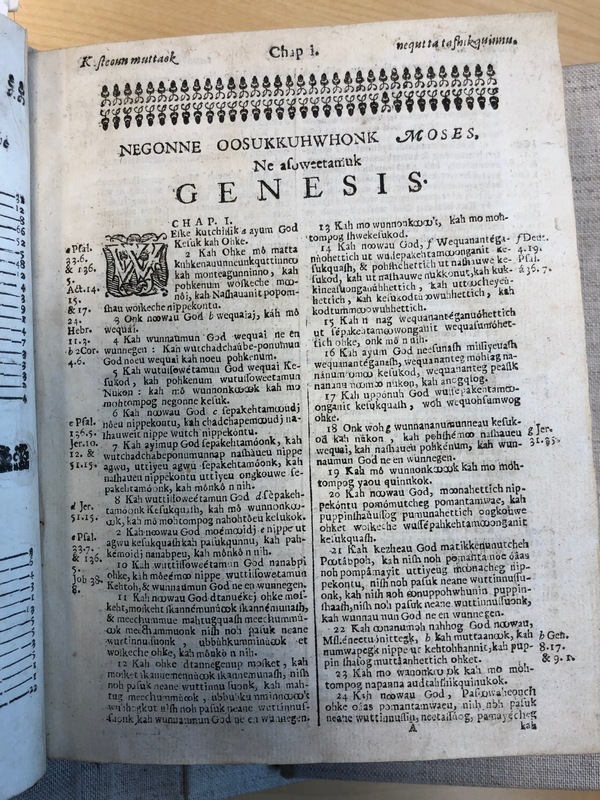 John Eliot Bible
John Eliot Bible The First Edition John Eliot bible was the first bible to be printed in English North America, published in 1663 in Cambridge, MA. The Bible was translated into Algonquin, and was said to be used as a tool for educating and converting the Native Americans. However, prior to the publishing of this bible there was no written Algonquin alphabet. The printing of this Bible is significant because it helps to illustrate one of the key motivations for colonizing New England — converting Indigenous peoples to Christianity. The printing of this bible in Algonquin was not only used as a tool for education, but it was also used as a means to demonstrate the progress that has been made in the efforts to convert Indigenous people. This shows how important the idea of religious conversion was at the time and how important it was that this progress be tangible in some way. Regardless of effectiveness the printing of the John Eliot bible depicts the motivations for further colonization. (Brillante)
-
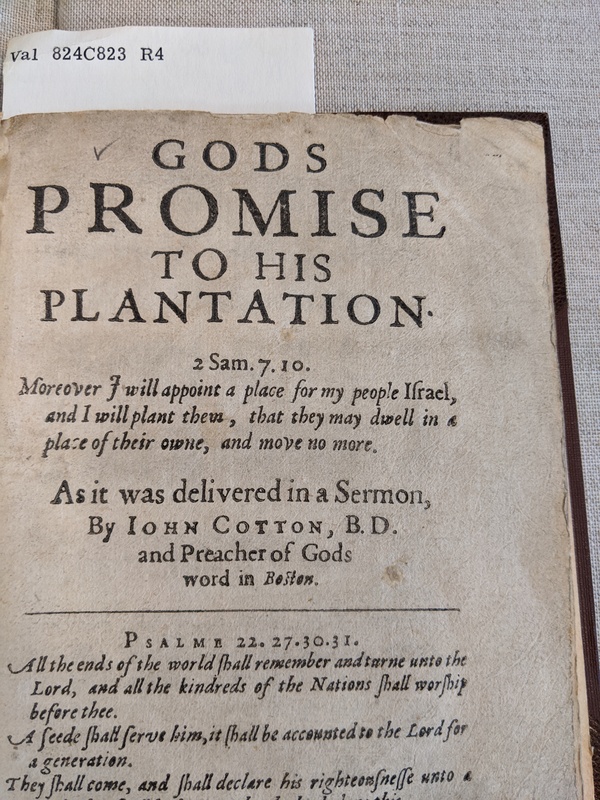 Gods Promise to His Plantation
Gods Promise to His Plantation This item is the exact sermon that John Cotton gave in Boston. it is for anyone who wants to learn or hear the sermon, particularly English speaking Christians.
-
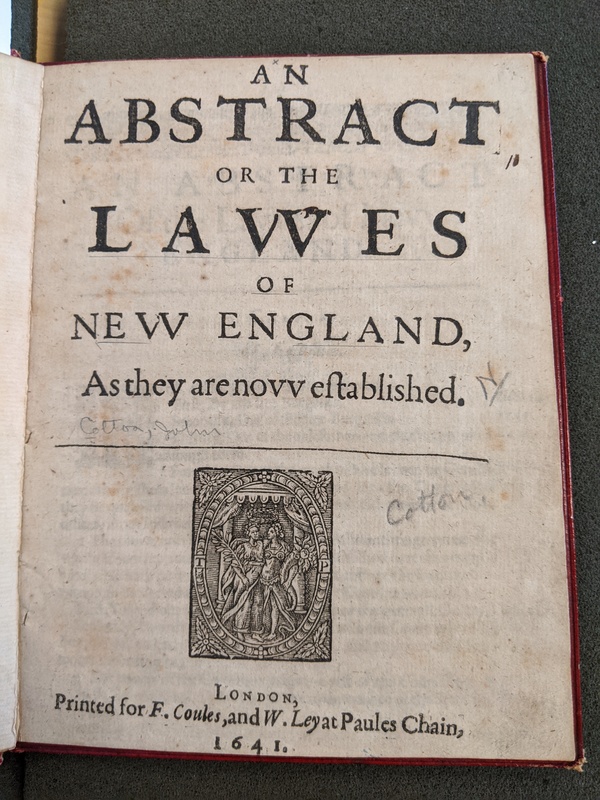 An Abstract or the Lawes of New England As they are novv established.
An Abstract or the Lawes of New England As they are novv established. This abstract contains a general description of the laws in New England in the mid 1650s. It is laid out in chapters, with each chapter enumerating the laws pertaining to a certain group of people. There are chapters detailing laws relating to magistrates, burgesses and free inhabitants, the protection and provision of the country, the right of inheritance, commerce, trespasses, severe crimes, minor crimes, and the trial of cases.
-
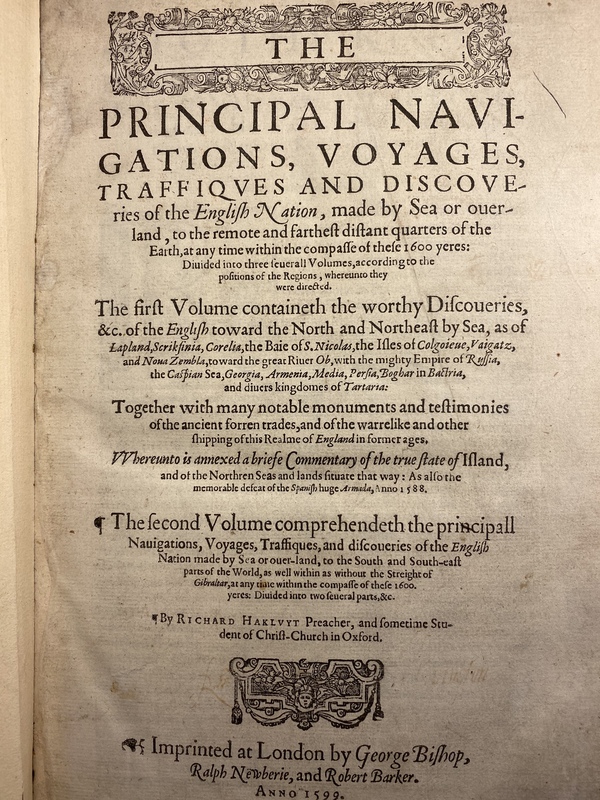 The principal navigations, voyages, traffiques and discoveries of the English nation : made by sea or ouerland, to the remote and farthest distant quarters of the earth, at any time within the compasse of these 1600 yeres
The principal navigations, voyages, traffiques and discoveries of the English nation : made by sea or ouerland, to the remote and farthest distant quarters of the earth, at any time within the compasse of these 1600 yeres This volume represents Hakluyt's collection of accounts from dozens of English explorers, pirates included, who were beginning to reshape Britain's worldview and its economic platform. The accounts in this two-volume publication present observations of Eastern Europe, the Americas, and parts of Asia. The initial objective of Hakluyt's Voyages was to aid in further exploration of these regions as well as to assist his nation in international trade, of which he was an ardent proponent.
-
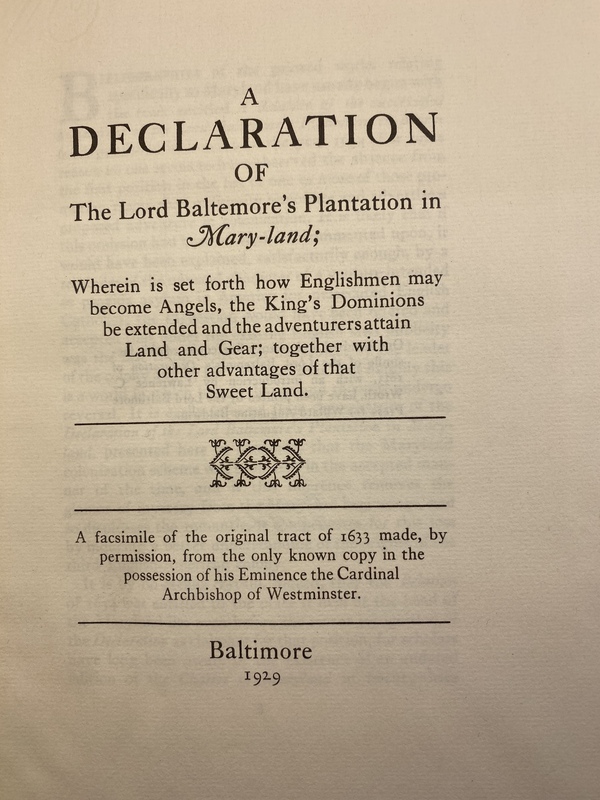 A declaration of the Lord Baltemore's plantation in Maryland ; wherein is set forth how Englishmen may become angels, the King's dominions be extended and the adventurers attain land and gear; together with other advantages of that sweet land
A declaration of the Lord Baltemore's plantation in Maryland ; wherein is set forth how Englishmen may become angels, the King's dominions be extended and the adventurers attain land and gear; together with other advantages of that sweet land This document outlines Lord Baltimore's economic and social visions for the colony of Maryland. It lists the various natural commodities available to them through this land, all with the purpose of extending the "king's dominion." Noticeably absent is discussion of religion, despite Baltimore's Catholicism; instead, the document roots itself in loyalty to England and the King.
-
 Acts and Laws, Passed by the General Court or Assembly of His Majesties Province of New-Hampshire in New-England
Acts and Laws, Passed by the General Court or Assembly of His Majesties Province of New-Hampshire in New-England Table of Contents from the document detailing the laws that governed New Hampshire through the early eighteenth century. Noteworthy is the absence of laws pertaining to witchcraft, which demonstrates the separation of superstition from government and much of the civil population following the Salem Witch Trials.
-
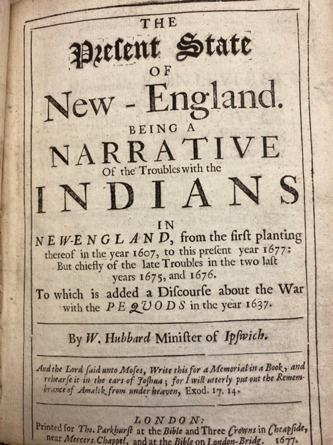 Map from The Present State of New-England Being a Narrative of the Troubles with the Indians in New-England...
Map from The Present State of New-England Being a Narrative of the Troubles with the Indians in New-England... This map details specifically which English settlements have been attacked by Native Americans and how many colonists have been injured or killed as a result (as indicated by the number next to those town's names). This is also a significant map because it was the first one drawn and designed in Boston, meaning it gives a pastoral view of the land instead of an imperial one.
The significance of this map comes can be known from the inscription in its top right corner: “A Map of New England, being the first that was ever cut here…” In other words, this was the first map produced in the English colonies. The fact that this first map is created for the explicit purpose of publicizing the agonies and violence wrought upon English settlers by the Native Americans in the surrounding areas speaks to the contentious relationship between the two groups. The pastoral view of the land that this map provides, in contrast to the imperial view of colonies set forth in maps for the British empire, informs us of two of the most pressing issues for early colonists: protection against violence perpetrated by Native Americans and the establishment of churches and religious organization. The presence of churches is indicated by the steeple cross on the buildings depicted next to some town names. (Dugar)
-
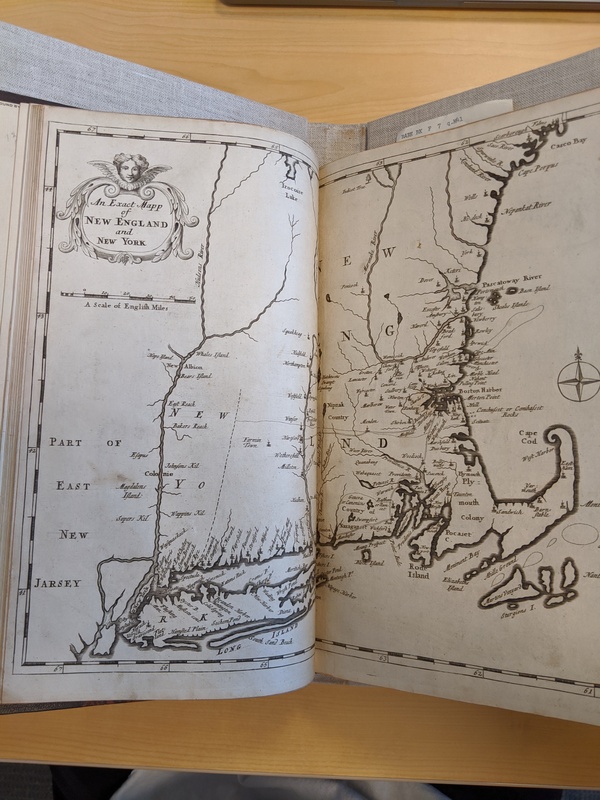 An Exact Mapp of New England and New York
An Exact Mapp of New England and New York A map of New England and New York created by Cotton Mather. It includes a scale (in English miles), a compass and locations of towns and villages, as well as geographical features.
-
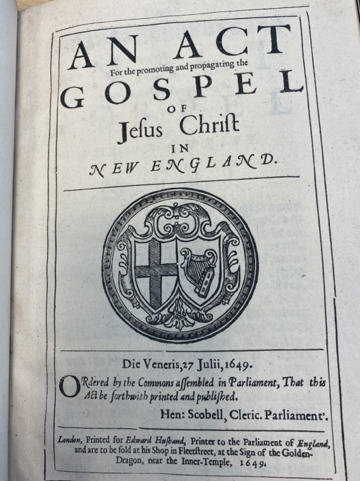 An act for the promoting and propagating the gospel of Jesus Christ in New England.
An act for the promoting and propagating the gospel of Jesus Christ in New England. The primary motive of many British colonists immigrating to the Americas through the mid-1600s was religious, be that finding religious liberty or refuge for oneself or attempting to convert indigenous peoples to Christianity. For the latter purpose, Parliament passed this Act to encourage fundraising for both Eliot Bibles and Prayer Towns, both created by Reverend John Eliot. The Act raised thousands of pounds of sterling meant to fund the establishment of these towns and publish what became known as Eliot Bibles. Prayer towns were founded on the principles of educating and “civilizing” Native Americans by exposing them to Christian gospel. The Eliot Bibles, because they were written in an Algonquin alphabet created by Eliot himself, were not so much helpful to Native Americans as it was evidence to Parliament and the Anglican Church of the work that Eliot and other preachers were doing to expand Christendom and bring glory to England.
-
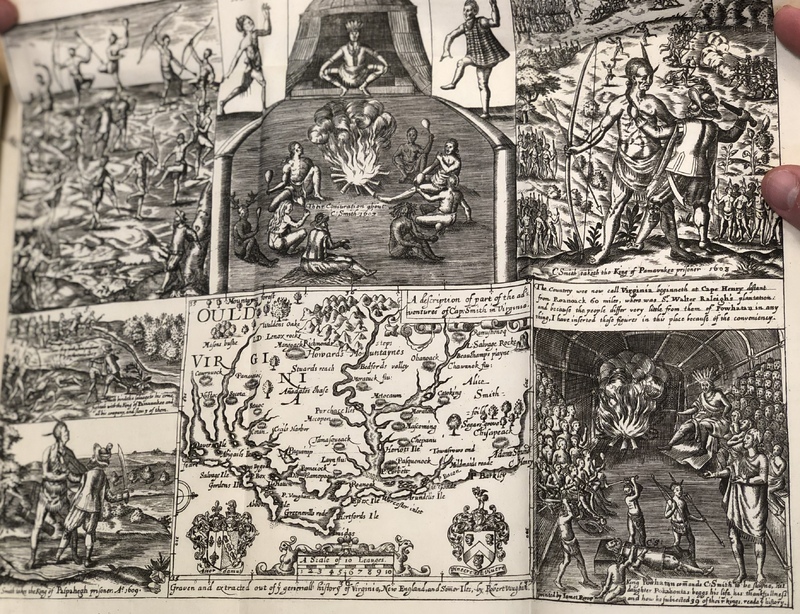 Frontispiece for John Smith's The Generall Historie of Virginia, New-England
Frontispiece for John Smith's The Generall Historie of Virginia, New-England This image is a composed of a series of graphic panels that detail John Smith’s interactions with the Powatain people of Virginia. These heavily propagandized illustrations demonstrate European notions of superiority and views on the indigenous people, drawing attention to their physical prowess. This is seen in the bottom-left most panel where Smith combats an indigenous male who is nearly a head taller than him. The difference in stature is significant because it is representative of the author’s broader aims. Namely, to draw attention to English Puritan’a success in spite of the native’s dominant physicality.
-
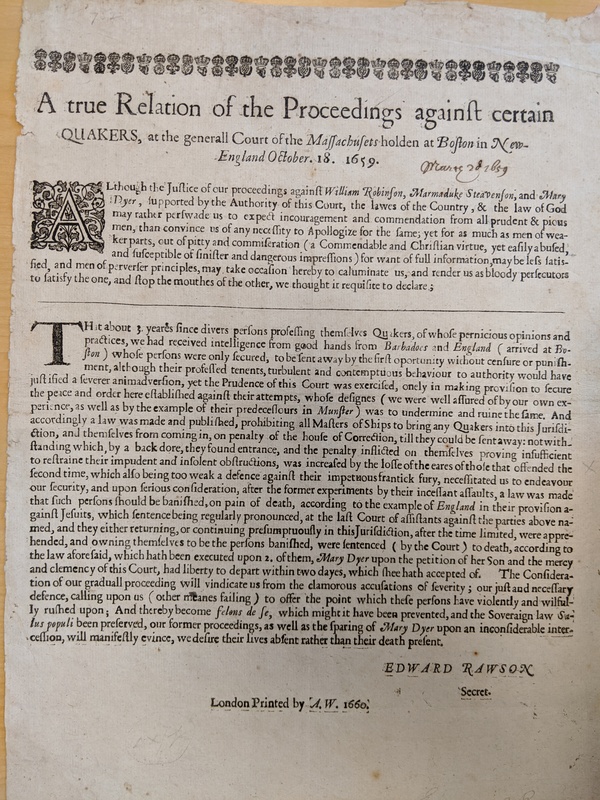 A True Relation of the Proceedings against certain quakers, at the general Court of the Massachusets holden at Boston in New-England
A True Relation of the Proceedings against certain quakers, at the general Court of the Massachusets holden at Boston in New-England One man's interpretation of a trial of three Quakers (William Robinson, Marmaduke Steavenson, and Mary Dyer) in the general court of Massachussets. This item is intended to inform people of the proceedings that occurred and the punishments that were enumerated (death penalty for Robinson and Steavenson, banishment for Dyer).
-
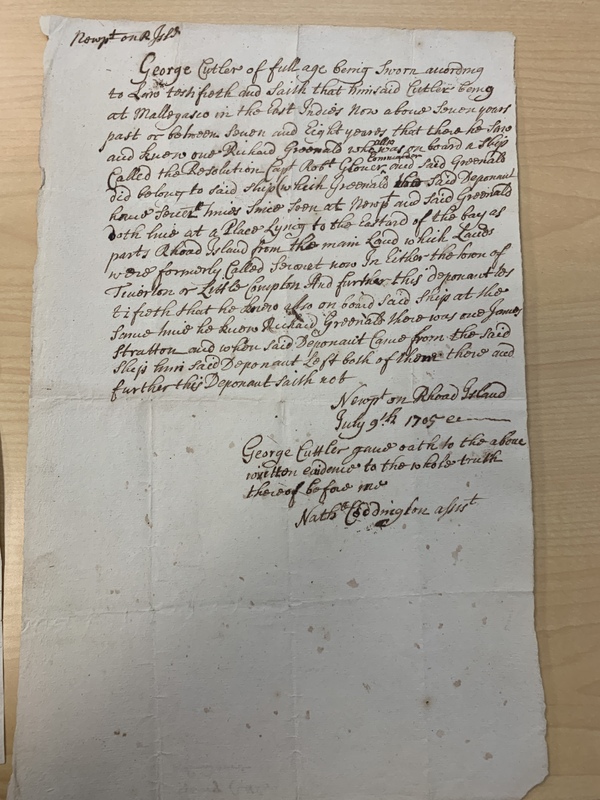 Deposition of Pirate George Cutler
Deposition of Pirate George Cutler The deposition of Pirate George Cutler regarding an inquiry into another local pirate Richard Grinnell of Little Compton and possibly James Stratton, Pirates aboard the ship Resolution under Pirate Captain Robert Glover
-
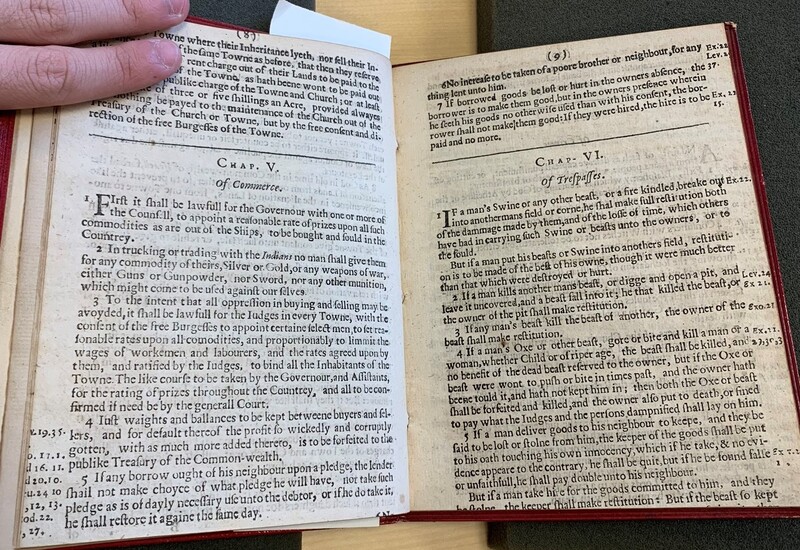 Commerce--Lawes of New England
Commerce--Lawes of New England This summary of commercial laws set forth regulations over what could and couldn't be sold, along with who is in charge of future commercial statutes. #2 on the list, for example, outlaws the sale of guns or silver or gold to Indians. #3 writes that local burgesses and judges have the power to set prices and wages.
-
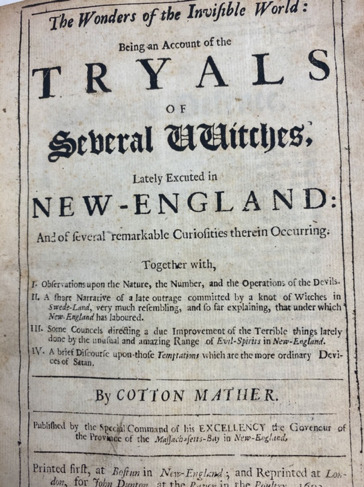 The Wonders of the Invisible World : Being an Account of the Tryals of Several Witches, Lately Excuted in New-England : and of Several Remarkable Curiosities Therein Occurring
The Wonders of the Invisible World : Being an Account of the Tryals of Several Witches, Lately Excuted in New-England : and of Several Remarkable Curiosities Therein Occurring Cotton Mather's accounts of the Salem Witch Trials, which justified the trials by making a case for the supernatural. It also demonstrates the puritan minister's at-times active support for the witch-hunt.
 John Eliot Bible The First Edition John Eliot bible was the first bible to be printed in English North America, published in 1663 in Cambridge, MA. The Bible was translated into Algonquin, and was said to be used as a tool for educating and converting the Native Americans. However, prior to the publishing of this bible there was no written Algonquin alphabet. The printing of this Bible is significant because it helps to illustrate one of the key motivations for colonizing New England — converting Indigenous peoples to Christianity. The printing of this bible in Algonquin was not only used as a tool for education, but it was also used as a means to demonstrate the progress that has been made in the efforts to convert Indigenous people. This shows how important the idea of religious conversion was at the time and how important it was that this progress be tangible in some way. Regardless of effectiveness the printing of the John Eliot bible depicts the motivations for further colonization. (Brillante)
John Eliot Bible The First Edition John Eliot bible was the first bible to be printed in English North America, published in 1663 in Cambridge, MA. The Bible was translated into Algonquin, and was said to be used as a tool for educating and converting the Native Americans. However, prior to the publishing of this bible there was no written Algonquin alphabet. The printing of this Bible is significant because it helps to illustrate one of the key motivations for colonizing New England — converting Indigenous peoples to Christianity. The printing of this bible in Algonquin was not only used as a tool for education, but it was also used as a means to demonstrate the progress that has been made in the efforts to convert Indigenous people. This shows how important the idea of religious conversion was at the time and how important it was that this progress be tangible in some way. Regardless of effectiveness the printing of the John Eliot bible depicts the motivations for further colonization. (Brillante) Gods Promise to His Plantation This item is the exact sermon that John Cotton gave in Boston. it is for anyone who wants to learn or hear the sermon, particularly English speaking Christians.
Gods Promise to His Plantation This item is the exact sermon that John Cotton gave in Boston. it is for anyone who wants to learn or hear the sermon, particularly English speaking Christians. An Abstract or the Lawes of New England As they are novv established. This abstract contains a general description of the laws in New England in the mid 1650s. It is laid out in chapters, with each chapter enumerating the laws pertaining to a certain group of people. There are chapters detailing laws relating to magistrates, burgesses and free inhabitants, the protection and provision of the country, the right of inheritance, commerce, trespasses, severe crimes, minor crimes, and the trial of cases.
An Abstract or the Lawes of New England As they are novv established. This abstract contains a general description of the laws in New England in the mid 1650s. It is laid out in chapters, with each chapter enumerating the laws pertaining to a certain group of people. There are chapters detailing laws relating to magistrates, burgesses and free inhabitants, the protection and provision of the country, the right of inheritance, commerce, trespasses, severe crimes, minor crimes, and the trial of cases. The principal navigations, voyages, traffiques and discoveries of the English nation : made by sea or ouerland, to the remote and farthest distant quarters of the earth, at any time within the compasse of these 1600 yeres This volume represents Hakluyt's collection of accounts from dozens of English explorers, pirates included, who were beginning to reshape Britain's worldview and its economic platform. The accounts in this two-volume publication present observations of Eastern Europe, the Americas, and parts of Asia. The initial objective of Hakluyt's Voyages was to aid in further exploration of these regions as well as to assist his nation in international trade, of which he was an ardent proponent.
The principal navigations, voyages, traffiques and discoveries of the English nation : made by sea or ouerland, to the remote and farthest distant quarters of the earth, at any time within the compasse of these 1600 yeres This volume represents Hakluyt's collection of accounts from dozens of English explorers, pirates included, who were beginning to reshape Britain's worldview and its economic platform. The accounts in this two-volume publication present observations of Eastern Europe, the Americas, and parts of Asia. The initial objective of Hakluyt's Voyages was to aid in further exploration of these regions as well as to assist his nation in international trade, of which he was an ardent proponent. A declaration of the Lord Baltemore's plantation in Maryland ; wherein is set forth how Englishmen may become angels, the King's dominions be extended and the adventurers attain land and gear; together with other advantages of that sweet land This document outlines Lord Baltimore's economic and social visions for the colony of Maryland. It lists the various natural commodities available to them through this land, all with the purpose of extending the "king's dominion." Noticeably absent is discussion of religion, despite Baltimore's Catholicism; instead, the document roots itself in loyalty to England and the King.
A declaration of the Lord Baltemore's plantation in Maryland ; wherein is set forth how Englishmen may become angels, the King's dominions be extended and the adventurers attain land and gear; together with other advantages of that sweet land This document outlines Lord Baltimore's economic and social visions for the colony of Maryland. It lists the various natural commodities available to them through this land, all with the purpose of extending the "king's dominion." Noticeably absent is discussion of religion, despite Baltimore's Catholicism; instead, the document roots itself in loyalty to England and the King. Acts and Laws, Passed by the General Court or Assembly of His Majesties Province of New-Hampshire in New-England Table of Contents from the document detailing the laws that governed New Hampshire through the early eighteenth century. Noteworthy is the absence of laws pertaining to witchcraft, which demonstrates the separation of superstition from government and much of the civil population following the Salem Witch Trials.
Acts and Laws, Passed by the General Court or Assembly of His Majesties Province of New-Hampshire in New-England Table of Contents from the document detailing the laws that governed New Hampshire through the early eighteenth century. Noteworthy is the absence of laws pertaining to witchcraft, which demonstrates the separation of superstition from government and much of the civil population following the Salem Witch Trials. Map from The Present State of New-England Being a Narrative of the Troubles with the Indians in New-England... This map details specifically which English settlements have been attacked by Native Americans and how many colonists have been injured or killed as a result (as indicated by the number next to those town's names). This is also a significant map because it was the first one drawn and designed in Boston, meaning it gives a pastoral view of the land instead of an imperial one. The significance of this map comes can be known from the inscription in its top right corner: “A Map of New England, being the first that was ever cut here…” In other words, this was the first map produced in the English colonies. The fact that this first map is created for the explicit purpose of publicizing the agonies and violence wrought upon English settlers by the Native Americans in the surrounding areas speaks to the contentious relationship between the two groups. The pastoral view of the land that this map provides, in contrast to the imperial view of colonies set forth in maps for the British empire, informs us of two of the most pressing issues for early colonists: protection against violence perpetrated by Native Americans and the establishment of churches and religious organization. The presence of churches is indicated by the steeple cross on the buildings depicted next to some town names. (Dugar)
Map from The Present State of New-England Being a Narrative of the Troubles with the Indians in New-England... This map details specifically which English settlements have been attacked by Native Americans and how many colonists have been injured or killed as a result (as indicated by the number next to those town's names). This is also a significant map because it was the first one drawn and designed in Boston, meaning it gives a pastoral view of the land instead of an imperial one. The significance of this map comes can be known from the inscription in its top right corner: “A Map of New England, being the first that was ever cut here…” In other words, this was the first map produced in the English colonies. The fact that this first map is created for the explicit purpose of publicizing the agonies and violence wrought upon English settlers by the Native Americans in the surrounding areas speaks to the contentious relationship between the two groups. The pastoral view of the land that this map provides, in contrast to the imperial view of colonies set forth in maps for the British empire, informs us of two of the most pressing issues for early colonists: protection against violence perpetrated by Native Americans and the establishment of churches and religious organization. The presence of churches is indicated by the steeple cross on the buildings depicted next to some town names. (Dugar) An Exact Mapp of New England and New York A map of New England and New York created by Cotton Mather. It includes a scale (in English miles), a compass and locations of towns and villages, as well as geographical features.
An Exact Mapp of New England and New York A map of New England and New York created by Cotton Mather. It includes a scale (in English miles), a compass and locations of towns and villages, as well as geographical features. An act for the promoting and propagating the gospel of Jesus Christ in New England. The primary motive of many British colonists immigrating to the Americas through the mid-1600s was religious, be that finding religious liberty or refuge for oneself or attempting to convert indigenous peoples to Christianity. For the latter purpose, Parliament passed this Act to encourage fundraising for both Eliot Bibles and Prayer Towns, both created by Reverend John Eliot. The Act raised thousands of pounds of sterling meant to fund the establishment of these towns and publish what became known as Eliot Bibles. Prayer towns were founded on the principles of educating and “civilizing” Native Americans by exposing them to Christian gospel. The Eliot Bibles, because they were written in an Algonquin alphabet created by Eliot himself, were not so much helpful to Native Americans as it was evidence to Parliament and the Anglican Church of the work that Eliot and other preachers were doing to expand Christendom and bring glory to England.
An act for the promoting and propagating the gospel of Jesus Christ in New England. The primary motive of many British colonists immigrating to the Americas through the mid-1600s was religious, be that finding religious liberty or refuge for oneself or attempting to convert indigenous peoples to Christianity. For the latter purpose, Parliament passed this Act to encourage fundraising for both Eliot Bibles and Prayer Towns, both created by Reverend John Eliot. The Act raised thousands of pounds of sterling meant to fund the establishment of these towns and publish what became known as Eliot Bibles. Prayer towns were founded on the principles of educating and “civilizing” Native Americans by exposing them to Christian gospel. The Eliot Bibles, because they were written in an Algonquin alphabet created by Eliot himself, were not so much helpful to Native Americans as it was evidence to Parliament and the Anglican Church of the work that Eliot and other preachers were doing to expand Christendom and bring glory to England. Frontispiece for John Smith's The Generall Historie of Virginia, New-England This image is a composed of a series of graphic panels that detail John Smith’s interactions with the Powatain people of Virginia. These heavily propagandized illustrations demonstrate European notions of superiority and views on the indigenous people, drawing attention to their physical prowess. This is seen in the bottom-left most panel where Smith combats an indigenous male who is nearly a head taller than him. The difference in stature is significant because it is representative of the author’s broader aims. Namely, to draw attention to English Puritan’a success in spite of the native’s dominant physicality.
Frontispiece for John Smith's The Generall Historie of Virginia, New-England This image is a composed of a series of graphic panels that detail John Smith’s interactions with the Powatain people of Virginia. These heavily propagandized illustrations demonstrate European notions of superiority and views on the indigenous people, drawing attention to their physical prowess. This is seen in the bottom-left most panel where Smith combats an indigenous male who is nearly a head taller than him. The difference in stature is significant because it is representative of the author’s broader aims. Namely, to draw attention to English Puritan’a success in spite of the native’s dominant physicality. A True Relation of the Proceedings against certain quakers, at the general Court of the Massachusets holden at Boston in New-England One man's interpretation of a trial of three Quakers (William Robinson, Marmaduke Steavenson, and Mary Dyer) in the general court of Massachussets. This item is intended to inform people of the proceedings that occurred and the punishments that were enumerated (death penalty for Robinson and Steavenson, banishment for Dyer).
A True Relation of the Proceedings against certain quakers, at the general Court of the Massachusets holden at Boston in New-England One man's interpretation of a trial of three Quakers (William Robinson, Marmaduke Steavenson, and Mary Dyer) in the general court of Massachussets. This item is intended to inform people of the proceedings that occurred and the punishments that were enumerated (death penalty for Robinson and Steavenson, banishment for Dyer). Deposition of Pirate George Cutler The deposition of Pirate George Cutler regarding an inquiry into another local pirate Richard Grinnell of Little Compton and possibly James Stratton, Pirates aboard the ship Resolution under Pirate Captain Robert Glover
Deposition of Pirate George Cutler The deposition of Pirate George Cutler regarding an inquiry into another local pirate Richard Grinnell of Little Compton and possibly James Stratton, Pirates aboard the ship Resolution under Pirate Captain Robert Glover Commerce--Lawes of New England This summary of commercial laws set forth regulations over what could and couldn't be sold, along with who is in charge of future commercial statutes. #2 on the list, for example, outlaws the sale of guns or silver or gold to Indians. #3 writes that local burgesses and judges have the power to set prices and wages.
Commerce--Lawes of New England This summary of commercial laws set forth regulations over what could and couldn't be sold, along with who is in charge of future commercial statutes. #2 on the list, for example, outlaws the sale of guns or silver or gold to Indians. #3 writes that local burgesses and judges have the power to set prices and wages. The Wonders of the Invisible World : Being an Account of the Tryals of Several Witches, Lately Excuted in New-England : and of Several Remarkable Curiosities Therein Occurring Cotton Mather's accounts of the Salem Witch Trials, which justified the trials by making a case for the supernatural. It also demonstrates the puritan minister's at-times active support for the witch-hunt.
The Wonders of the Invisible World : Being an Account of the Tryals of Several Witches, Lately Excuted in New-England : and of Several Remarkable Curiosities Therein Occurring Cotton Mather's accounts of the Salem Witch Trials, which justified the trials by making a case for the supernatural. It also demonstrates the puritan minister's at-times active support for the witch-hunt.